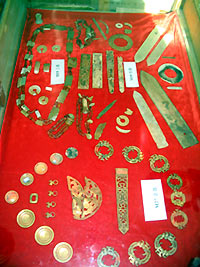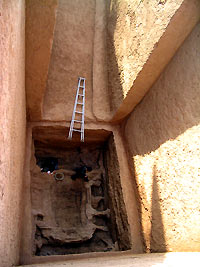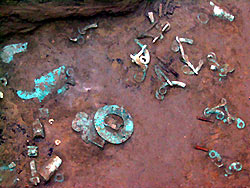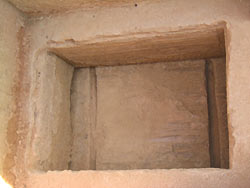| Tools: Save | Print | E-mail | Most Read |
| Zhou Dynasty Tombs Unearthed in Shaanxi |
| Adjust font size: |
At a December 16 press conference cosponsored by the Shaanxi Provincial Culture Relics Bureau and the Hancheng City government, archaeologists announced the successful excavation of numerous and highly significant cultural relics from several ancient grave sites in Hancheng City, in northwestern China's Shaanxi Province. The relics date back approximately 2,800 years, from late western Zhou Dynasty (c. 1100 BC - c. 771 BC) to the early Eastern Zhou Dynasty (770 BC - 256 BC). At the press conference it was revealed that the tombs yielded four large-scale graves, with more than a dozen pits with representations of horses, chariots and many rare ceremonial wares in bronze, gold and jade. Archeologists theorize that the site is the grave of a state ruler who may have held some prominence during the Zhou Dynasty (c. 1100 BC - 221 BC). In August 2004, a villager reported to Hancheng Municipal Cultural Relics Bureau that thieves had attempted to rob some of the ancient tombs at the Liangdai Village 7 km north of Hancheng City. The Hancheng Cultural Relics and Tourism Bureau and Public Security Bureau moved to increase security in the area, and better protect the high-level cultural gravesites that had been kept safe from pilferage for more than three decades.
After a six-month excavation, archaeologists determined that the cluster of tombs span an area of 330,000 square meters -- 600 meters at the east-west perimeter, and 550 meters at the south-north boundary. Although only 10 percent of the site was excavated during the six months, discovered there were 103 tombs and 17 horses and chariots pits. The archeologists considered the exploration of the four largest graves to be most significant. Jiao Nanfeng, leader of the archaeological team, revealed that articles unearthed included more than 600 pieces of bronze ware, as well as rare gold articles and lacquer ware. The finds are considered to be highly important for the continued research into the political and economic systems and funerary customs of the Zhou Dynasty.
Jiao said the excavation of this site was the most significant find in Shaanxi Province, and one of the most important discoveries in China in 2005. Liu Yunhui, deputy director of Shaanxi Provincial Culture Relics Bureau, stated that application will be made for the site to be designated as the sixth batch of major historical and cultural sites under state protection. The State Administration of Cultural Heritage has approved the application and is awaiting the nod of the State Council.
(China.org.cn by Chen Lin December 26, 2005) |
| Tools: Save | Print | E-mail | Most Read |
 |
| Related Stories |
|
| Product Directory China Search |
Country Search Hot Buys |






